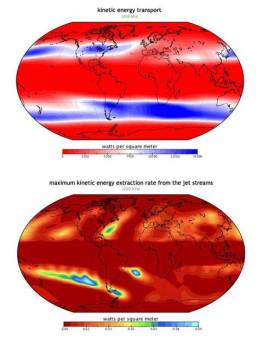High altitude wind power harnessing not as efficient as previously though
 The high winds were thought to be a rich potential source of renewable energy, however, a study by researchers from the Max Planck Institute for Biogeochemistry in Jena, Germany, shows that the near absence of friction and absence of strong propulsion cause the jet streams that sweep the upper atmosphere to harness about 200 times less energy than previously estimated.
The high winds were thought to be a rich potential source of renewable energy, however, a study by researchers from the Max Planck Institute for Biogeochemistry in Jena, Germany, shows that the near absence of friction and absence of strong propulsion cause the jet streams that sweep the upper atmosphere to harness about 200 times less energy than previously estimated.
The jet streams exist due to solar radiation which heats the tropics more than the polar regions, thus causing differential in the atmosphere. This differential leads to a drop in air pressure, and this pressure difference is causing the shift of air. The power and direction of the jet streams arise through the accelerating effect of pressure changes in the upper atmosphere and the Coriolis force generated by the Earth’s rotation. Meteorological science has shown that the jet streams at heights of 7 to 16 kilometers are subjected to nearly no friction and move at constant speed of over 90 kilometers per hour (56 mph).
“It is precisely this low energy requirement that limits the potential for using the jet streams as a source of renewable energy”, said Axel Kleidon, head of the Independent Max Planck Research Group on Biospheric Theory and Modelling.
By using climate simulation models, Kleidon’s group has calculated the maximum rate at which wind energy can be taken from the global atmosphere. According to their calculations, the jet streams have an output of only 7.5 terawatts – 200 times less usable wind energy than previously expected, and less than a half of humankind’s primary energy requirements from year 2010.
The Max Planck Institute researchers also studied how climate would change if the jet streams were tapped into on a large scale as a source of renewable energy. Every wind turbine establishes a resistance in order to convert wind energy into power, and the balance of forces in the jet stream is altered as soon as that energy is removed from it. In case we somehow manage to create turbines capable to harvest the full power contained in the jet streams, the researchers predict a massive alteration of the balance.
“If we used wind turbines to take 7.5 terawatts out of the atmosphere at the level of the jet streams, about 300 terawatts less energy would be generated in the atmosphere as a whole”, said Lee Miller, lead author of the study. “This would have a drastic impact on temperature and weather.”
Their simulations predict that pressure difference between the equatorial region and the poles would disappear, and the whole climate system would slow down.
“Our investigations show that the potential of the jet streams as a source of renewable energy was overestimated”, said Kleidon. “It is incumbent on us to carefully study the global impact of renewable energy technologies that seem environmentally sound.”
For more information, you can read the research paper published in the journal Earth System Dynamics named: “Jet stream wind power as a renewable energy resource: little power, big impacts” (PDF).










We have not tapped in spec of global Wind onshore and offshore,why think of High altitude wind power? Crazy?
Dr.A.Jagadeesh Nellore(AP),India
Wind Energy Expert
E-mail: anumakonda.jagadeesh@gmail.com